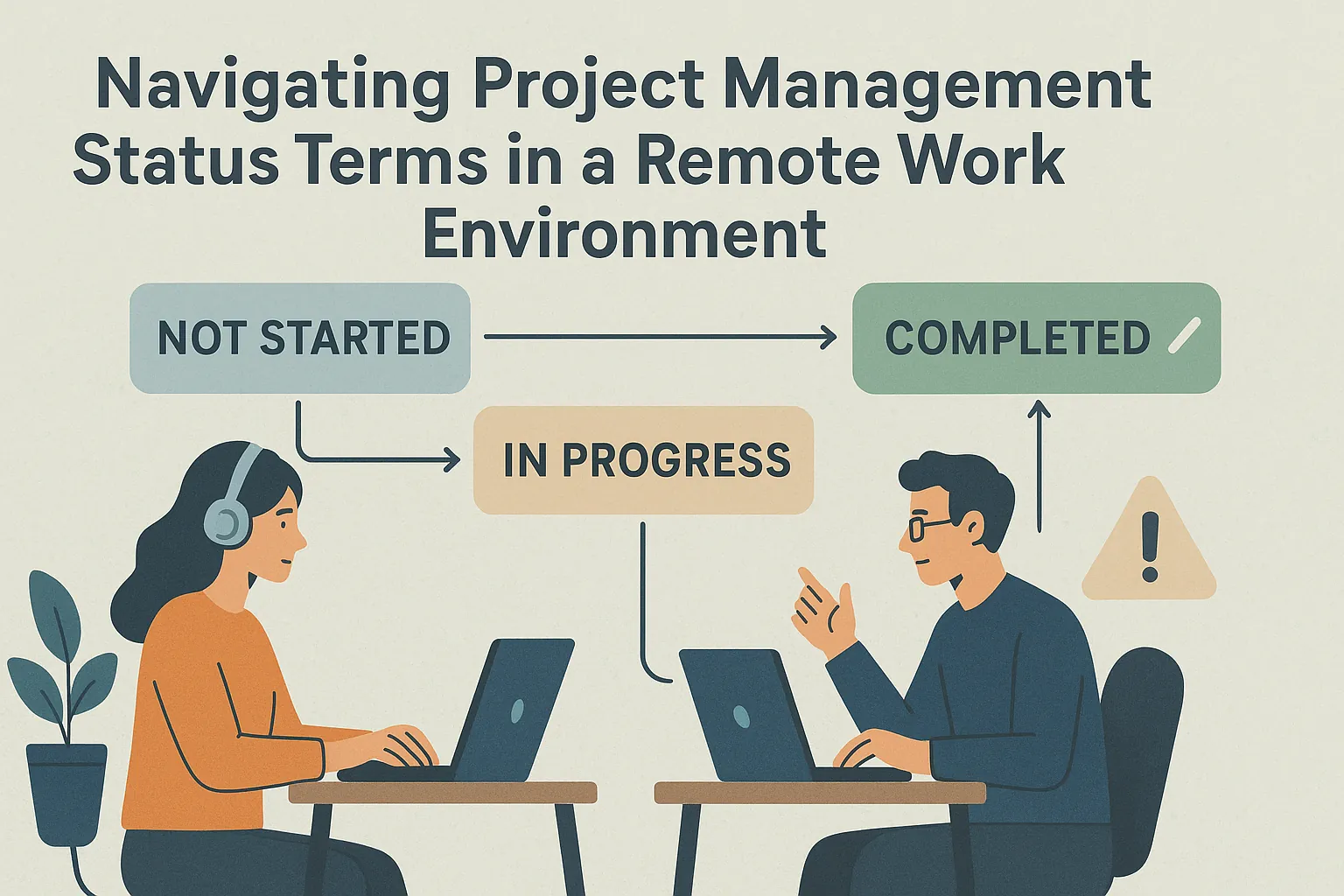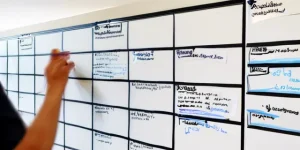Introduction to Project Management Status Terms
Particularly within remote work environments, the clarity of communication is paramount. Project management status terms serve as a common language that helps teams understand the progress and challenges of their projects. This section aims to provide a foundational understanding of these terms, emphasizing their significance in ensuring effective collaboration among remote teams.
Definition of Project Management Status Terms
Project management status terms refer to specific phrases or labels used to describe the current state of a project or its components. These terms help project managers and team members convey information succinctly and effectively, allowing for quick assessments of progress and areas needing attention. Common status terms include “On Track,” “At Risk,” “Delayed,” and “Completed,” each providing a snapshot of where a project stands at any given moment.
Importance of Clear Communication in Remote Teams
In a remote work setting, where team members may be spread across different locations and time zones, clear communication becomes even more critical. The absence of face-to-face interactions can lead to misunderstandings and misinterpretations. By utilizing standardized project management status terms, teams can:
- Enhance Understanding: Clear status updates ensure that all team members are on the same page regarding project progress and expectations.
- Facilitate Quick Decision-Making: When status terms are well-defined, project managers can make informed decisions swiftly, addressing issues before they escalate.
- Promote Accountability: Clearly defined status terms help team members understand their responsibilities and the overall project timeline, fostering a sense of ownership.
Overview of Common Status Terms Used in Project Management
Understanding the common status terms used in project management is essential for effective communication. Here are some frequently used terms:
- On Track: Indicates that the project is progressing as planned and is expected to meet deadlines.
- At Risk: Signifies that there are potential issues that could impact the project’s timeline or quality, requiring attention.
- Delayed: Used when a project or task is behind schedule, necessitating a reassessment of timelines and resources.
- Completed: Marks the successful conclusion of a project or task, indicating that all objectives have been met.
By familiarizing remote teams with these terms, project managers can foster a culture of transparency and collaboration, ultimately leading to more successful project outcomes.
The Challenges of Remote Communication
Within remote teams, effective communication is paramount. However, several challenges can hinder clarity and understanding when conveying project status. Here are some key points to consider:
- Geographical Barriers and Time Zone Differences: Remote work often involves team members spread across various locations, leading to significant time zone differences. This can complicate scheduling meetings and synchronizing updates, making it difficult for teams to stay aligned on project progress. According to KPMG, 46% of project managers report struggling with virtual communication, which is exacerbated by these geographical challenges [4].
- Lack of Non-Verbal Cues in Virtual Communication: In face-to-face interactions, non-verbal cues such as body language and facial expressions play a crucial role in conveying messages. However, in a remote setting, these cues are often absent, leading to potential misunderstandings. The inability to read emotions can result in misinterpretation of status updates, as team members may not fully grasp the tone or urgency behind a message [3][2].
- Potential for Misinterpretation of Status Updates: The asynchronous nature of remote communication can lead to confusion regarding project status. Without immediate feedback, team members may misinterpret the intent or content of updates. This challenge is compounded by the fact that 43% of project managers find managing timelines difficult in a virtual environment, highlighting the need for clear and concise communication strategies [4][5].
To navigate these challenges effectively, remote project managers should prioritize establishing clear communication protocols, utilize collaborative tools that enhance visibility, and foster an environment where team members feel comfortable seeking clarification when needed. By addressing these communication hurdles, teams can maintain clarity and cohesion, ultimately leading to more successful project outcomes.
Common Project Management Status Terms Explained
Clear communication is essential for ensuring that all team members are aligned and aware of the project’s progress. Understanding and effectively using project management status terms can significantly enhance clarity and collaboration among remote teams. Below are some common status terms, along with real-world examples and tips on their appropriate usage.
1. On Track
- Definition: This status indicates that a project or task is progressing as planned, meeting deadlines and objectives.
- Example: A software development team is on track with their sprint goals, having completed all planned features for the week without any issues.
- Usage Tip: Use “On Track” to communicate confidence in the project’s progress. It reassures stakeholders that everything is proceeding according to the timeline and expectations.
2. At Risk
- Definition: This term signifies that a project or task may not meet its deadlines or objectives due to potential issues that have been identified.
- Example: A marketing campaign is at risk because a key team member is out sick, which may delay the content creation process.
- Usage Tip: When using “At Risk,” provide specific details about the risks involved and potential impacts. This helps the team to address the issues proactively and develop mitigation strategies.
3. Delayed
- Definition: This status indicates that a project or task is behind schedule and will not be completed by the originally planned deadline.
- Example: A remote team working on a product launch has encountered delays due to unforeseen technical challenges, pushing the launch date back by two weeks.
- Usage Tip: Clearly communicate the reasons for the delay and any revised timelines. This transparency helps manage expectations and allows for better planning moving forward.
4. Completed
- Definition: This term signifies that a project or task has been finished and all deliverables have been met.
- Example: A remote team has completed the development of a new feature, and it has passed all testing phases, ready for deployment.
- Usage Tip: Use “Completed” to celebrate achievements and recognize team efforts. It’s also beneficial to provide a brief summary of what was accomplished to reinforce the value of the completed work.
5. Blocked
- Definition: This status indicates that progress on a project or task has halted due to an obstacle that needs to be resolved.
- Example: A project is blocked because the team is waiting for feedback from a client, which is necessary to proceed with the next phase of development.
- Usage Tip: When stating that a task is “Blocked,” specify the nature of the blockage and what is needed to resolve it. This encourages team members to collaborate on finding solutions and helps to expedite the resolution process.
Best Practices for Communicating Status in Remote Teams
Effective communication of project status is crucial for remote teams to ensure everyone is aligned and informed. Here are some best practices to enhance clarity in status communication among remote project managers and their teams:
- Establish Standardized Terminology for Status Updates: Creating a common language for status updates helps eliminate confusion. Define specific terms such as “on track,” “at risk,” and “delayed” to ensure all team members interpret status reports consistently. This standardization fosters a shared understanding of project health and progress, which is essential in a remote environment where visual cues are often absent [1][4].
- Utilize Tools and Platforms for Clear Communication: Leverage various communication tools that facilitate effective status updates. Video conferencing, instant messaging, and project management software can help maintain clarity. These platforms allow for real-time updates and discussions, making it easier for team members to stay informed about project developments [5][6]. Additionally, using asynchronous writing can be beneficial, as it allows team members to provide updates at their convenience, accommodating different time zones and schedules [8].
- Encourage Regular Status Check-Ins and Updates: Schedule consistent check-ins to discuss project status. Regular meetings, whether daily or weekly, provide opportunities for team members to share updates, voice concerns, and celebrate milestones. This practice not only keeps everyone informed but also fosters a sense of accountability and team cohesion [2][3]. Moreover, encouraging team members to share their progress and challenges openly can lead to collaborative problem-solving and enhanced project outcomes [7].
By implementing these best practices, remote project managers can significantly improve the clarity and effectiveness of status communication within their teams, ultimately leading to more successful project management outcomes.
Creating a Status Update Framework
Maintaining clarity in status communication is crucial for ensuring that all team members are aligned and informed. A well-structured status update framework can significantly enhance the effectiveness of communication among remote teams. Here are some key components and recommendations for delivering project status updates effectively:
Components of a Comprehensive Status Update
- Objectives: Clearly define the goals of the project. This sets the context for the status update and helps team members understand what they are working towards. It is essential to reiterate these objectives regularly to keep everyone focused and aligned.
- Progress: Provide a detailed account of what has been accomplished since the last update. This should include completed tasks, milestones reached, and any metrics that demonstrate progress. Highlighting achievements not only boosts morale but also reinforces accountability among team members.
- Challenges: Address any obstacles or issues that have arisen during the project. Being transparent about challenges fosters a culture of openness and encourages team members to collaborate on solutions. It is important to discuss how these challenges may impact timelines or deliverables.
- Next Steps: Outline the upcoming tasks and milestones, assigning responsibilities and due dates to specific team members. This clarity helps in setting expectations and ensures that everyone knows their role in moving the project forward [1][2].
Frequency and Format Recommendations for Status Updates
- Regular Updates: Establish a routine for status updates, such as weekly or bi-weekly meetings. This frequency allows for timely communication of progress and challenges while keeping the team engaged and informed. Daily stand-up meetings can also be beneficial for quick catch-ups and alignment on goals [6][9].
- Format: Choose a format that suits your team’s needs. This could be a written report, a presentation, or a live meeting. The key is to ensure that the format is accessible and easy to digest for all team members. Consistency in format helps team members know what to expect and makes it easier to track progress over time [3][4].
Incorporating Visual Aids for Clarity
- Charts and Dashboards: Utilize visual aids such as charts, graphs, and dashboards to present data in a clear and engaging manner. Visual representations of progress can help team members quickly grasp the status of the project and identify areas that require attention. Tools like Gantt charts or Kanban boards can be particularly effective in illustrating timelines and task statuses [5][8].
- Infographics: Consider creating infographics that summarize key points from the status update. These can be shared in team communications and serve as a quick reference for team members to understand the project’s current state at a glance.
By implementing a structured approach to status updates, remote project managers can enhance communication, foster collaboration, and drive project success. This framework not only clarifies expectations but also empowers team members to take ownership of their tasks, ultimately leading to a more productive and cohesive remote work environment.
Fostering a Culture of Transparency and Accountability
Fostering a culture of transparency and accountability is essential for effective status communication. Here are some key strategies to maintain clarity and enhance collaboration among remote teams:
- Encouraging Team Members to Share Both Successes and Challenges: It is vital to create an environment where team members feel comfortable sharing their achievements as well as the obstacles they encounter. This openness not only celebrates individual and team successes but also allows for collective problem-solving when challenges arise. Regular check-ins can facilitate this sharing process, ensuring that everyone is aware of both progress and potential roadblocks [2][5].
- Establishing Trust Through Open Communication: Trust is the foundation of any successful team, especially in a remote setting. By establishing clear communication channels and protocols, project managers can ensure that all team members remain informed and connected. This transparency fosters a sense of belonging and encourages team members to voice their thoughts and concerns without fear of judgment. Utilizing various communication tools, such as video conferencing and instant messaging, can enhance this open dialogue [1][3][4].
- Recognizing Contributions and Addressing Issues Promptly: Acknowledging the efforts and contributions of team members is crucial in maintaining morale and motivation. Regularly recognizing achievements, no matter how small, can boost team spirit and encourage continued effort. Conversely, addressing issues promptly is equally important. When challenges are identified early, they can be managed effectively, preventing them from escalating into larger problems. Implementing project management tools that allow visibility into each member’s responsibilities and progress can aid in this process, promoting accountability and transparency [6][7][8].
By integrating these practices into the project management framework, remote teams can cultivate a culture that values transparency and accountability, ultimately leading to more effective communication and project success.
Tools and Technologies to Enhance Status Communication
In a remote work environment, maintaining clarity in project status communication is crucial for project managers and their teams. The right tools can significantly enhance collaboration and ensure that everyone is on the same page regarding project progress. Here’s an overview of popular project management tools, the benefits of real-time collaboration tools, and how to integrate status reporting features into existing workflows.
Overview of Popular Project Management Tools
- Asana: Asana is a task and project management platform that allows teams to create projects, assign tasks, and track progress. It enhances communication by providing a clear visual representation of project timelines and responsibilities, making it easier for remote teams to stay aligned on their goals [3][8].
- Trello: Trello utilizes a visual board system with lists and cards to help teams organize and prioritize tasks. This tool is particularly effective for remote teams as it allows for easy updates and visibility into the status of various tasks, fostering transparency and accountability [3].
- Jira: Jira is widely used in software development for tracking issues and project management. It offers robust reporting features and customizable workflows, which can help remote teams manage their projects more effectively by providing detailed insights into project status and team performance [3].
Benefits of Using Real-Time Collaboration Tools
- Instant Communication: Tools like Slack and Microsoft Teams facilitate instant messaging and video conferencing, allowing team members to communicate in real-time. This immediacy helps in quickly addressing any project-related queries or issues, which is essential in a remote setting [5][9].
- Centralized Information: These platforms serve as a central hub for all project-related discussions, files, and updates. By keeping all communication in one place, teams can easily refer back to previous conversations and decisions, reducing the chances of miscommunication [5][10].
- Enhanced Collaboration: Real-time collaboration tools enable teams to work together on documents and projects simultaneously. This feature is particularly beneficial for remote teams, as it allows for seamless collaboration regardless of geographical location [6].
Integrating Status Reporting Features into Existing Workflows
- Utilizing Built-in Reporting Tools: Many project management tools, such as Asana and Jira, come with built-in reporting features that allow teams to generate status updates automatically. By integrating these features into regular workflows, project managers can ensure that status reports are consistently updated and easily accessible [4][8].
- Custom Dashboards: Creating custom dashboards within project management tools can provide a quick overview of project status at a glance. This allows team members to see key metrics and updates without having to sift through multiple reports or communications [4].
- Regular Check-ins: Incorporating regular status check-ins using video conferencing tools can enhance communication. These meetings can serve as a platform for discussing project progress, addressing challenges, and aligning on next steps, ensuring that everyone remains informed and engaged [1][5].
By leveraging these tools and technologies, remote project managers can enhance clarity in status communication, ultimately leading to more effective project management and successful outcomes.
Conclusion: The Path to Clear Status Communication
The clarity of status communication is paramount. As teams operate from various locations, the potential for misunderstandings increases, making it essential to establish and maintain clear status terms. Here are the key takeaways to ensure effective communication among remote teams:
- Importance of Clear Status Terms: Clear communication guidelines help ensure that all team members are aligned and understand project progress. Establishing specific status terms allows for a common language that can reduce confusion and enhance collaboration. This is particularly crucial in remote settings where non-verbal cues are absent, and misinterpretations can easily occur [1][5].
- Final Tips for Enhancing Communication: Utilize Diverse Communication Tools: Leverage various platforms such as video conferencing for meetings, instant messaging for quick updates, and project management software for tracking progress. This multi-faceted approach can cater to different communication needs and preferences within the team [2][9].
- Regular Check-Ins: Schedule consistent team meetings to discuss project status and address any concerns. These check-ins foster a sense of connection and accountability among team members, ensuring everyone is informed and engaged [7][9].
- Encourage Open Dialogue: Promote an environment where team members feel comfortable sharing updates, challenges, and feedback. This openness can lead to more effective problem-solving and a stronger team dynamic [6][8].
- Encouragement to Adapt and Refine Communication Strategies: The landscape of remote work is continually evolving, and so should your communication strategies. Regularly assess the effectiveness of your communication methods and be open to making adjustments based on team feedback and project needs. This adaptability will not only enhance clarity but also improve overall team performance [4][5].
By implementing these best practices, remote project managers can navigate the complexities of status communication, ensuring that their teams remain cohesive and productive, regardless of geographical barriers.
Find out more about Shaun Stoltz https://www.shaunstoltz.com/about/.
This post was written by an AI and reviewed/edited by a human.



